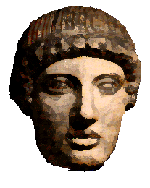Reviews
I Bacchanti di Euripide
in Teatro Greco, Palazzolo Acréide, 27 May 2005
Performed by Liceo "Carlo Botta", Ivrea (TO) as part of the XIth Festival Internazionale del Teatro Classico dei Giovani.
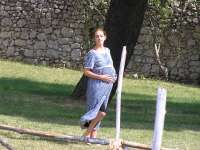
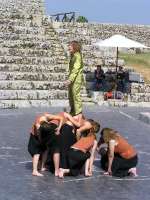 A heavily pregnant Semele emerges from the trees behind the stage. As she writhes, a female Dionysus in a gold lamé Elvis-type suit tenderly helps her up and leads her off. The chorus enter in black skirts and brown vests, and Dionysus delivers her opening speech standing on their backs. Teiresias and Cadmus are portrayed mockingly by chorus members; they also mime a sparagmos. There is no music - but they stamp their feet effectively in a rhythm borrowed from Queen.
A heavily pregnant Semele emerges from the trees behind the stage. As she writhes, a female Dionysus in a gold lamé Elvis-type suit tenderly helps her up and leads her off. The chorus enter in black skirts and brown vests, and Dionysus delivers her opening speech standing on their backs. Teiresias and Cadmus are portrayed mockingly by chorus members; they also mime a sparagmos. There is no music - but they stamp their feet effectively in a rhythm borrowed from Queen.
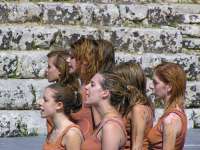 Pentheus appears - he's the only male in the cast - but has long hair, just like Dionysus'. He wears a black suede jacket and trousers - an early pop idol reject. His voice is weak, and he has no presence - he quite fails to hold the attention of the young audience who chatter constantly, unaware how every sound is audible in this well-constructed ancient theatre.
Pentheus appears - he's the only male in the cast - but has long hair, just like Dionysus'. He wears a black suede jacket and trousers - an early pop idol reject. His voice is weak, and he has no presence - he quite fails to hold the attention of the young audience who chatter constantly, unaware how every sound is audible in this well-constructed ancient theatre.
The actors use frontal orientation - and their movement is lumbering compared with the professionals at Siracusa. The audience clap anything that takes their fancy! The chorus are young and sexy - the choreography is well-planned, with good use of their bamboo-pole thyrsi.
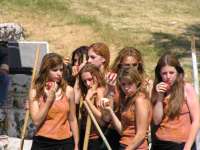 On "to the mountains" there is sudden accordion music as the chorus turn round, revealing white masks on the backs of their heads. The accordionist turns out to be the messenger, occasionally accompanying herself: the two speeches seem to have been combined. The chorus join in a silent dance of triumph, with much knee slapping. Since the start there has been a puzzling row of large red apples across the scaena. Ah! Now they pick up the apples and bite into them - is this a symbolic omophagia? A member of the chorus enters as Agave - with an apple: this is Pentheus' head, of course. The rest of the chorus munch noisily during her dialogue with the other choreute who (inaudibly) plays Cadmus. They look like two girls having a chat in the piazza!
On "to the mountains" there is sudden accordion music as the chorus turn round, revealing white masks on the backs of their heads. The accordionist turns out to be the messenger, occasionally accompanying herself: the two speeches seem to have been combined. The chorus join in a silent dance of triumph, with much knee slapping. Since the start there has been a puzzling row of large red apples across the scaena. Ah! Now they pick up the apples and bite into them - is this a symbolic omophagia? A member of the chorus enters as Agave - with an apple: this is Pentheus' head, of course. The rest of the chorus munch noisily during her dialogue with the other choreute who (inaudibly) plays Cadmus. They look like two girls having a chat in the piazza!
Dionysus appears behind us at the back of the cavea, as the chorus exit. Now there's music! ("This is the end" by XTC) - the curtain call is thus the most animated part of the show, and is followed by enthusiastic presentations to the director/choreographer.
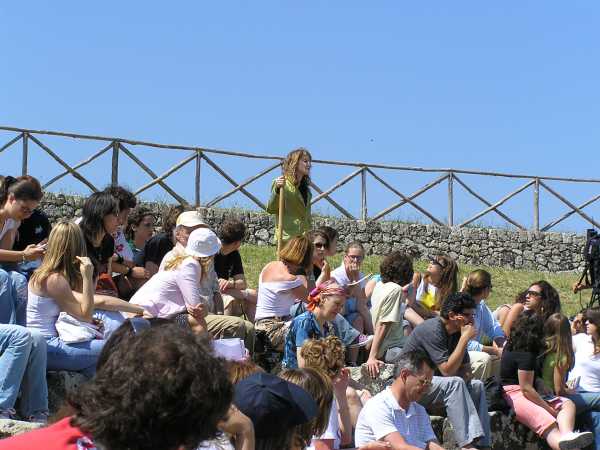
A lively and entertaining dance-centred production by a young cast: there was no sense however that this was a tragedy.

